Before World War II, Jimmy Doolittle was already a world-famous aviator, but it was his daring raid on Tokyo following the attack on Pearl Harbor that cemented his place in history.
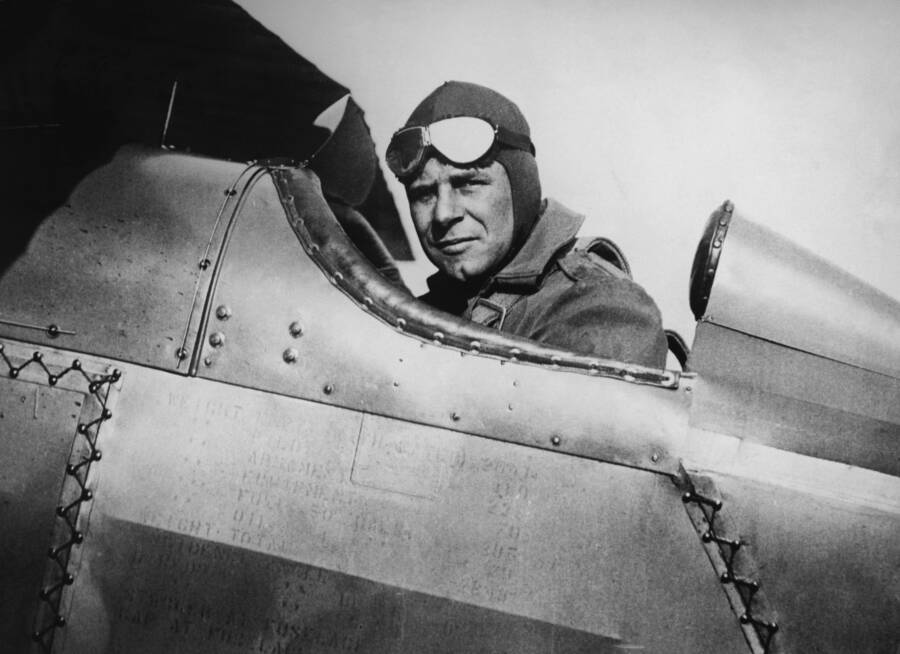
Hulton-Deutsch/Getty ImagesJimmy Doolittle after completing his historic flight across the Andes Mountains in 1926.
Jimmy Doolittle set the world on fire with his daredevil aerial stunts. But he made his name in history through a daring raid that changed the course of World War II.
His Early Life
James “Jimmy” Harold Doolittle was born on December 14, 1896 the only child of Rosa and Frank Doolittle. In his autobiography, Doolittle claimed that he was born without a first name since his birth certificate just read “Doolittle.” He wrote, “The ‘James’ and ‘Harold’ were added later and I have no idea where they came from.”
His father was carpenter who moved the family to Nome, Alaska during the gold rush just six months after Jimmy was born. As a town on the remote American frontier, Nome at that time was a rough place.
In a 1993 interview, published in World War II Magazine in 2003, Doolittle recalled, “It was a dangerous area, for certain. There were saloons, prostitutes, everything. The real Wild West. There was no law to speak of; everyone carried weapons, and they used them. Gambling was rampant, and crime increased with the growing population.”
Being the shortest boy in his class and subjected to taunts, he quickly learned to defend himself. By 1908, the relationship between father and son had become strained and his mother wanted him to have a better education than could be found in Nome. He moved to Los Angeles with his mother, he would see his father only one more time in his life.
He was exposed to flight for the first time at the Dominguez airfield outside of Los Angeles in 1908. He immediately was taken by it and tried to build a homemade glider.
Doolittle recalled that he “…followed the instructions in an old Popular Mechanics magazine. My mother sewed the fabric for my bi-plane adventure, although I think she was reluctant to provide me with any encouragement.
“This thing was more like a hang glider, and I took it to a small bluff with a 15-foot rise. I ran and jumped, but the tail struck and sent me crashing. Undeterred, I decided that I needed more speed.
“I had a friend tow me behind his father’s car with a rope, but I never got airborne and was dragged quite a way. My glider was destroyed, but I was very lucky myself.”
In the meanwhile, Doolittle enrolled at a trade school then to Los Angeles Junior College for mining engineering and then the Engineering School of the University of California at Berkeley. In the meantime, he met his wife Josephine who he married in 1917.
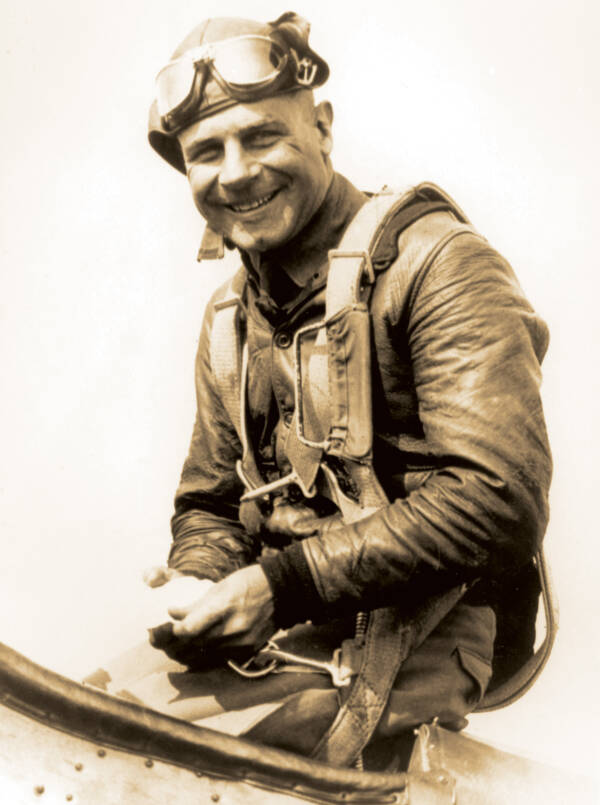
Wikimedia CommonsJimmy Doolittle in flight gear.
Jimmy Doolittle Takes Flight
The young Doolittle was about to earn a degree in engineering, but after the outbreak of World War I, he signed up for pilot training in the U.S. Signal Corps. He received his flight education at Rockwell Field in San Diego.
Tragically, on his first day of training he saw a flight accident that resulted in the death of a student.
Curiously, Doolittle would later write, “When the wreckage was cleared, Mr. Todd [the instructor] looked at me carefully and said we should get on with our business. I was shaken up by what I had seen but nodded in agreement, and we went up for the first lesson. If there is such a thing as love at first sight, my love for flying began on that day during that hour.”
At Rockwell Field, he quickly took to solo, cross-country, aerobatics, and formation flying.
Doolittle earned a commission as a second lieutenant and worked as a flight instructor. To his disappointment, he never saw any action despite attempts to transfer overseas. Disappointed, after the war he thought to return to engineering, but being in the air had a hold on his heart that would never let go.
He ended up becoming a stunt flyer for the Army Air Services which was meant to garner positive publicity to the post-war service. He became known for his daredevil stunts but gained his first notoriety in 1922 by being the first person to make a transcontinental flight in under 24 hours: the actual time being 21 hours and 19 minutes.
He was awarded a Distinguished Flying Cross for the feat. Simultaneously, he returned to the University at California to finish his degree and afterward studied aeronautics at MIT, earning a doctorate in 1925.

National Air and Space Museum, Smithsonian Institution (SI 79-9405).Doolittle and the First “Blind Flight.” The canvas next to him sealed him into the cockpit.
That same year he won the prestigious Schneider Trophy race for the United States flying a Curtiss Seaplane as well as demonstrated for the first time the aerial maneuver known as the “outside loop“. During this move, an aircraft performs a vertical loop with the pilot on the outside subjecting him to tremendous centrifugal forces. It was considered highly dangerous and his superiors banned him from doing it.
On September 24, 1929, he became the first pilot to fly “blind,” relying solely on his instruments to take off, tell him speed, direction, location, and land without visual reference.

Wikimedia CommonsJimmy Doolittle and his Curtiss Racer.
Doolittle often got in trouble with the brass. Doolittle recalled, “Once I pulled a stunt that was completely illegal, doing some wing-walking and other things, and Cecil B. DeMille caught me on camera. My CO found out about it really quick. He saw the film of me sitting there on the landing gear under John McCullough’s plane and grounded me for another month.”

National Air and Space Museum, Smithsonian Institution (SI 89-5925).Doolittle in the 1932 Thompson Trophy race.
In 1930, Doolittle left active service but remained in the reserve as a Major. He continued to fly and became the head of the Shell Oil Company’s nascent aviation department and promoted the development of 100-octane gasoline which would improve flight speed and performance. Meanwhile, he flew in competitions setting speed and distance records.
He won the first ever Bendix Trophy in 1931 and the Thompson Trophy in 1932 which he won in an oddly shaped and unstable Gee Bee R-1 Super Sportster. He was probably America’s best known aviator after Charles Lindbergh in the interwar period. But he was in many ways a superior pilot to him and a more groundbreaking pioneer in aviation.
The Doolittle Raid
After visits to Germany in 1937 and 1939, Doolittle was convinced of the inevitability of war. Giving up his well-paying position with Shell, he returned to the Air Corps on July 1, 1940.
Doolittle first assisted in converting the American automobile industry to produce of aircraft, but after the Japanese attack on Pearl Harbor on December 7, 1941 the government had another mission for him — to bomb Japan.

Jimmy Doolittle attaching a Japanese medal to a bomb meant to be dropped on Japan.
American morale after the Pearl Harbor attack was at a nadir and the country at large desired to avenge itself upon Japan.
In January 1942, war planners concocted a joint Army-Navy mission in which land-based bombers would be launched from an aircraft carrier to attack Japanese industrial centers. If the raid was successful, strategists believed that it would have a profound psychological impact on the Japanese.
Jimmy Doolittle, then a lieutenant colonel, was the perfect person to lead such an audacious scheme. He met with Vice Admiral William F. Halsey secretly in San Francisco to iron out the details.
The mission was to be one way. The modified sixteen B-25 bombers were able to launch from an aircraft carrier with relative safety, it was virtually impossible for them to land. Instead, the American raiders were to land in China after completing the mission. The eighty flyers were drilled relentlessly in night, low-altitude, evasion, and cross country flight.
In early April, the bombers were loaded onto the carrier USS Hornet, and on April 18 the carrier sailed to within 650 miles of Tokyo. However, they were soon detected by Japanese forces and needed to launch early.
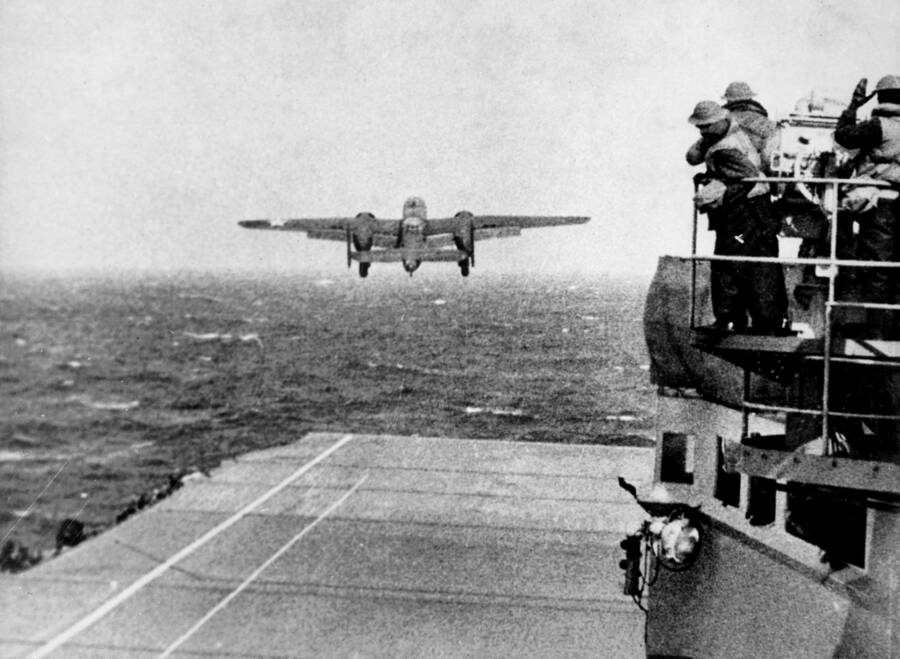
Wikimedia CommonsA Doolittle raider taking off from the USS Hornet.
Sixteen bombers with names such as Fickle Finger of Fate, TNT, Avenger, Bat out of Hell, Green Hornet, and Hari Kari-er started taking off and by 9:16 a.m. all the aircraft were bound for Japan. Six hours later, the raiders entered Japanese airspace. Japan’s military was taken completely off guard as Doolittle’s raiders bombed targets in Tokyo, including the inadvertent bombing of a school. In total, 87 Japanese died in the raid.
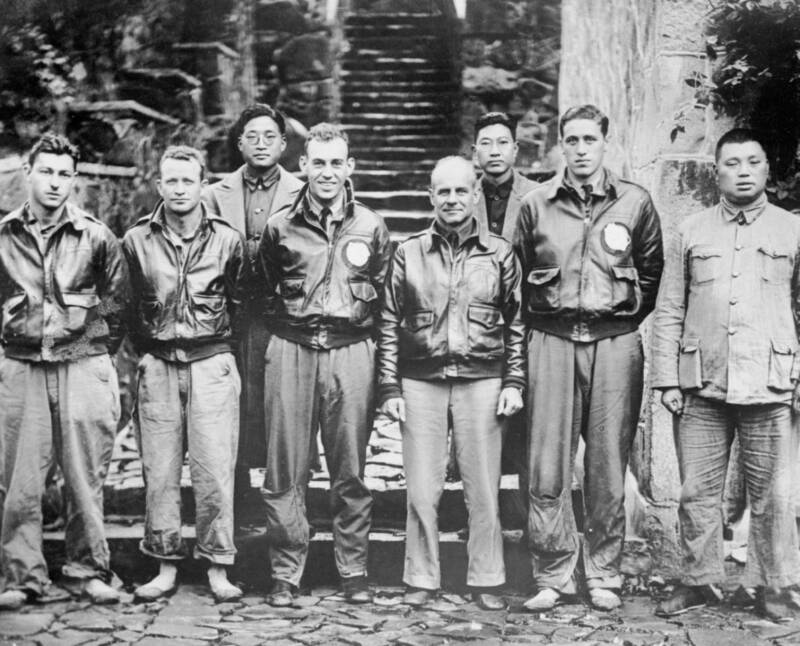
Wikimedia CommonsJimmy Doolittle with fellow raiders in China.
After The Bombs
Each of the bombers carrying the raiders met different fates. All crash-landed with one bomber crew landing in the neutral Soviet Union with the rest, including Doolittle, in China.
Doolittle later wrote, “I felt lower than a frog’s posterior. This was my first combat mission. I planned it from the beginning and led it. I was sure it was my last. As far as I was concerned, it was a failure, and I felt there was no future for me in uniform now. Even if we successfully accomplished the first half of our mission, the second half had been to deliver the B-25s to our units in the China-Burma-India theater of operations.”
But Doolittle had misjudged his success or the reaction of his superiors. He and most of the other pilots managed to sneak out of the country with Chinese assistance. For his daring-do he was awarded the Medal of Honor by President Franklin Roosevelt and promoted to brigadier-general.
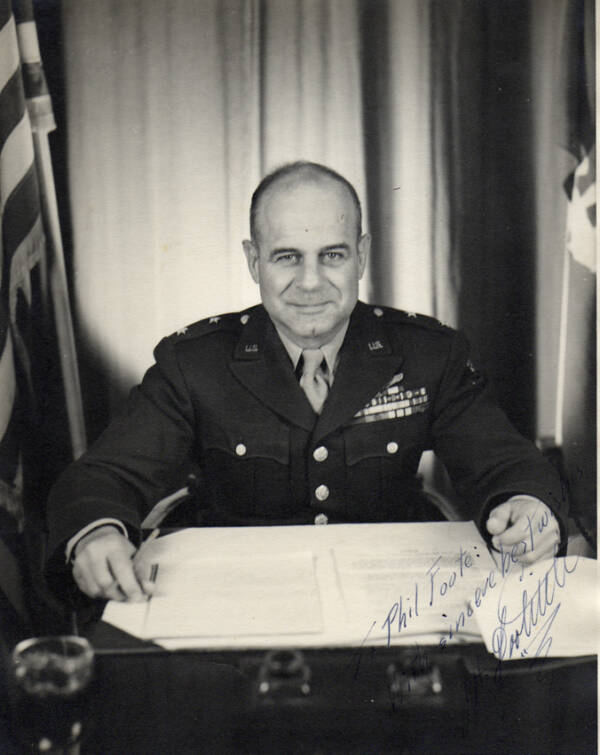
Wikimedia CommonsJimmy Doolittle during the war years.

Wikimedia CommonsPresident Franklin D. Roosevelt pinning Jimmy Doolittle with the Medal of Honor.
Reflection
Although the material success of Doolittle’s raid was negligible, it had a tremendous, positive impact on American morale. It also, as expected, impacted Japanese morale and hastened Japanese plans to increase their defensive perimeter around their home islands, which required the smashing of the U.S. Navy’s carrier force.
This resulted in the Battle of Midway in early June 1942 which was a turning point in the Pacific War.
The raid also led the Japanese military to massacre perhaps a quarter-million Chinese for helping the raiders escape.
Doolittle later would reflect on this terrible after-effect, “That was perhaps the greatest tragedy of our mission. All of that horror was retribution against the Chinese for helping us…. They also exacted their revenge against our captured men, which I learned of later… The loss of those men has always stayed with me. When people ask about the atomic bombs and their justification, they come to mind.”
The raid was truly the highlight of Doolittle’s career, but for the rest of the war he held various rising commands culminating in heading the Eighth Air Force with 42,000 aircraft. He ended the war as a Lieutenant General.
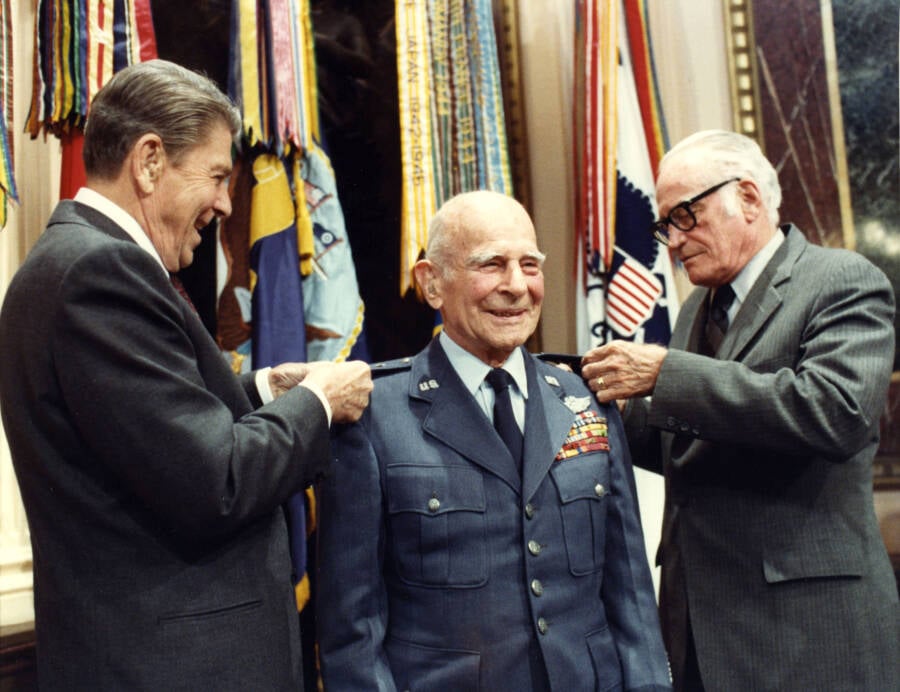
Wikimedia CommonsPresident Ronald Reagan and Senator Barry L. Goldwater pin the fourth star on Gen. James Doolittle on April 10, 1985.
The Various Honors Of Jimmy Doolittle
Jimmy Doolittle retired on May 10, 1946, but remained active, heading advisory boards and associations such as the National Advisory Committee for Aeronautics. He was given numerous awards and honors such as Congress promoting him to four-star general on the retired list in 1985 as well as the Presidential Medal of Freedom that same year. His name is found in both the Motorsports Hall of Fame and in the Aerospace Walk of Honor.
Jimmy Doolittle died on September 27, 1993, at age 96. One cannot help but be astounded by the incredible life of this aviation pioneer and war hero. Perhaps the title of his autobiography said it best, “I Could Never Be So Lucky Again.”
Now that you’ve read up on Jimmy Doolittle, read all about the Battle of Midway, which the Japanese Navy incited to prevent further raids on the Japanese homeland, or about badass U.S. Marine John Basilone, the only soldier in World War II to win both the Congressional Medal of Honor and the Navy Cross





